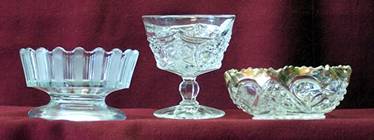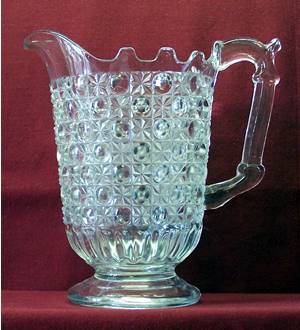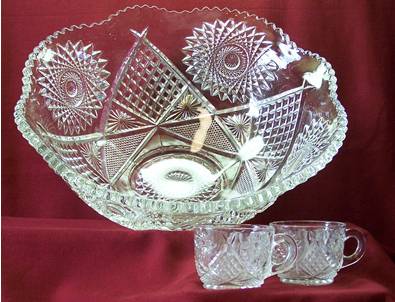 |
Goblets - Wines - Tumblers - Toothpicks - Compotes - Cake Stands
Banana Stands - Creamers - Spooner - Covered Sugar - Covered Butter
Relish Dish - Shot Glasses - Celery Vases - Rose Bowl - Buttermilks
Fruit Bowls - Bread Plates - Jelly Compote - Fruit Nappies
Water Pitchers - Milk Pitchers - Punch Bowls
Fruit Nappies
 The fruit nappy was used as an individual fruit dish, and was usually bought in a set with the fruit bowl. They vary in size depending on the pattern. The nappies that are small in size are great as nut dishes at a card party. The larger sized nappies are popular for serving desserts or as finger bowls. They are also very popular today, and affordable to put a votive candle in. Many people enjoy putting them on the bathroom counter with a candle, on the counter beside the tub while bathing, on the night table, decorating windows, just about anywhere. The fruit nappy was used as an individual fruit dish, and was usually bought in a set with the fruit bowl. They vary in size depending on the pattern. The nappies that are small in size are great as nut dishes at a card party. The larger sized nappies are popular for serving desserts or as finger bowls. They are also very popular today, and affordable to put a votive candle in. Many people enjoy putting them on the bathroom counter with a candle, on the counter beside the tub while bathing, on the night table, decorating windows, just about anywhere.
Water Pitchers
 The Water Pitcher was an essential part of your tableware setting. They were produced in many different shapes and sizes. Some are round and bulbous, others are tall and slender. The “bulbous” shaped water pitchers are ideal to have for serving a variety of beverages, including lemonade, iced tea, red or white wine and of course for serving water. These water pitchers are also popular for making a large flower arrangement, as they are similar in size and shape to many modern flower vases. The “tall tankard” water pitchers are commonly used for serving ice water, champagne, red or white wine and special fruit cocktails. The “tankard” water pitcher is ideal for smaller arrangements, with flowers that tend to have longer stems, such as roses and lilies or arrangements with one or two different flowers. Many people will dry flowers, and use the water pitchers as permanent decorative vases. There are two different kinds of water pitchers categorized by the handle of the pitcher. In the early stages of mold designing, it was known how to make a “one plunger” mold. This meant that mold makers would design a mold to press the body of the pitcher. After the body was pressed, a glass blower was hired to “blow and apply” the handle to the body of the pitcher. Often during this process the body of the pitcher would crack from the application of a hot handle attaching to the pitcher that had already cooled. If cracking occurred, the glass was melted and used to make another water pitcher. It wasn’t long until they discovered a “two plunger” mold, where the mold makers could press the handle directly to the body of the pitcher. The pitchers with a “pressed handle,” are more common as they were able to mass produce them, where the “applied handled” water pitchers are not as common, and harder to find, as there were not as many produced. Although the “applied handle” water pitchers tend to be more expensive, it is important to remember that pressed glass is very durable and that when you buy pressed glass you are investing in an antique that will last your life-time with simply care and not to be afraid to use it while it appreciates in value. The Water Pitcher was an essential part of your tableware setting. They were produced in many different shapes and sizes. Some are round and bulbous, others are tall and slender. The “bulbous” shaped water pitchers are ideal to have for serving a variety of beverages, including lemonade, iced tea, red or white wine and of course for serving water. These water pitchers are also popular for making a large flower arrangement, as they are similar in size and shape to many modern flower vases. The “tall tankard” water pitchers are commonly used for serving ice water, champagne, red or white wine and special fruit cocktails. The “tankard” water pitcher is ideal for smaller arrangements, with flowers that tend to have longer stems, such as roses and lilies or arrangements with one or two different flowers. Many people will dry flowers, and use the water pitchers as permanent decorative vases. There are two different kinds of water pitchers categorized by the handle of the pitcher. In the early stages of mold designing, it was known how to make a “one plunger” mold. This meant that mold makers would design a mold to press the body of the pitcher. After the body was pressed, a glass blower was hired to “blow and apply” the handle to the body of the pitcher. Often during this process the body of the pitcher would crack from the application of a hot handle attaching to the pitcher that had already cooled. If cracking occurred, the glass was melted and used to make another water pitcher. It wasn’t long until they discovered a “two plunger” mold, where the mold makers could press the handle directly to the body of the pitcher. The pitchers with a “pressed handle,” are more common as they were able to mass produce them, where the “applied handled” water pitchers are not as common, and harder to find, as there were not as many produced. Although the “applied handle” water pitchers tend to be more expensive, it is important to remember that pressed glass is very durable and that when you buy pressed glass you are investing in an antique that will last your life-time with simply care and not to be afraid to use it while it appreciates in value.
Milk Pitchers
 The milk pitcher was part of your table setting in the 1880’s. Similar to the water pitcher, milk pitchers came in various shapes and sizes, both with applied handles and pressed handles, but are generally smaller in size. Milk pitchers are popular today for salad dressings, syrup and gravy. They are also ideal if you are serving a selection of wines (red, white, blush), next to the water pitcher for your ice water. They are ideal for specialty drinks, like eggnog, tomato or vegetable cocktails, or for serving juices at the breakfast table. Milk pitchers are also used for smaller flower arrangements. The milk pitcher was part of your table setting in the 1880’s. Similar to the water pitcher, milk pitchers came in various shapes and sizes, both with applied handles and pressed handles, but are generally smaller in size. Milk pitchers are popular today for salad dressings, syrup and gravy. They are also ideal if you are serving a selection of wines (red, white, blush), next to the water pitcher for your ice water. They are ideal for specialty drinks, like eggnog, tomato or vegetable cocktails, or for serving juices at the breakfast table. Milk pitchers are also used for smaller flower arrangements.
Punch Bowls
 Punch bowls were used for serving a number of guests at a family or social function. The punch bowls came with either a pedestal to elevate the bowl on the table or a large underplate where the bowl would rest in the centre. Each set came with a set of punch cups. If a pedestal was used the cups were hung around the bowl using metal hooks. If the punch tray was used, the cups were displayed around the base of the bowl resting on the tray. Today, the punch sets are still used for serving punches as well as special holiday drinks, such as eggnog. When being used for punch, to add to the presentation, thinly slice an orange and add it to the punch. The orange slices float along the top, adding colour and appeal. An alternative to oranges are lemons or limes, depending on the flavor of your punch. For more colour, add cranberries or strawberries. When not being used for serving punches or specialty drinks, there are many other great uses. The punch bowls are popular for displaying colourful decorative balls, floating candles or as a large rose bowl (floating a variety of flowers in water). They are popular as a decoration for the centre of your table or on a sideboard. The large size of a punch bowl set makes an impressive statement just on it’s own. Many people today also use their Punch Bowls to serve salads at a large function. They are perfect for Caesar salads because you have good depth to mix the salad ingredients. Punch bowls were used for serving a number of guests at a family or social function. The punch bowls came with either a pedestal to elevate the bowl on the table or a large underplate where the bowl would rest in the centre. Each set came with a set of punch cups. If a pedestal was used the cups were hung around the bowl using metal hooks. If the punch tray was used, the cups were displayed around the base of the bowl resting on the tray. Today, the punch sets are still used for serving punches as well as special holiday drinks, such as eggnog. When being used for punch, to add to the presentation, thinly slice an orange and add it to the punch. The orange slices float along the top, adding colour and appeal. An alternative to oranges are lemons or limes, depending on the flavor of your punch. For more colour, add cranberries or strawberries. When not being used for serving punches or specialty drinks, there are many other great uses. The punch bowls are popular for displaying colourful decorative balls, floating candles or as a large rose bowl (floating a variety of flowers in water). They are popular as a decoration for the centre of your table or on a sideboard. The large size of a punch bowl set makes an impressive statement just on it’s own. Many people today also use their Punch Bowls to serve salads at a large function. They are perfect for Caesar salads because you have good depth to mix the salad ingredients.
Do you have new ideas to share?
Please e-mail us at info@pressedglassandgoblets.com
Sean George
Pressed Glass & Goblets
P.O. Box 369
Arthur, Ontario Canada
N0G 1A0
519-848-2200
Email: info@pressedglassandgoblets.com
|

